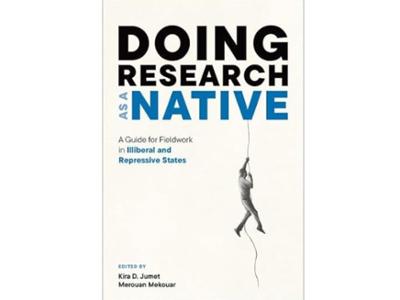Bookshelf
Alumni and faculty members who would like to have their books considered for this listing should contact Stacey Himmelberger, editor of Hamilton magazine. This list, which dates back to 2018, is updated periodically with books appearing alphabetically on the date of entry.
-
(Oxford University Press, 2025).
Along with Merouan Mekouar, a York University social scientist, Jumet compiled “narratives from 19 scholars, representing 15 countries in Africa, Asia, the Caribbean, Eastern Europe, South America, Central Asia, and South Asia, who conducted fieldwork in their native repressive and/or illiberal countries,” according to the publisher’s description.
Topic -
(Northwestern University Press, 2025)
A study of how unusually bright comets appeared not only in the sky in 1664-65 and 1680-81, but also in ballets and theater, letters and journalism, architecture and institutions, theology and literary style. The author, a French literature and culture professor at the University of California Davis, discusses how these comets — considered at the time to appear in random and unpredictable locations — sparked curiosity, scrutiny, resistance, and doubt regarding the epistemological status of observation.
Topic -
(Skyhorse Publishing, 2024)
For many families, homelessness is no longer someone else’s problem. It is right around the corner, a real threat in their own immediate future. The author goes on to maintain, “Our housing crisis is the result of a long history of government policies, court cases, and political manipulation. While these disparate causes make up a tangled web, they have one surprising root: the attack on private property rights. For more than a century, government policies and court decisions have attacked, undermined, and eroded private property rights. Whether it be exclusionary zoning, eminent domain abuse, rent control, or excessive environmental regulations, the cumulative impact of these assaults on private property is that it’s become increasingly difficult — or even impossible — to build adequate housing supplies to meet market demands. We are fast approaching a time when millions of typical Americans will, quite literally, have nowhere to live.”
Topic -
(Marrowstone Press, 2024)
In this, his fifth self-declared “last book” of poems (this time he probably means it!), Weltner devotes the first half to reflections on his time at Hamilton. The collection that fills the section “Late Winter Snow on College Hill” is dedicated to members of his Class of 1964 and in memory of his longtime friend Sam Crowl ’62.
Topic -
(self-published, 2025)
The author draws on his financial and tax background to provide a survey into the growing monetization of today’s college athletics. He outlines what he calls the “brutal outcomes” of college sports becoming professionalized, including the loss of billions of dollars in tax breaks and foregone revenue that would permanently alter the student-athlete experience. “Massive cuts to the size, number, and quality of non-revenue sports will consequently rob thousands of students of scholarship opportunities and deny higher education to many in the college-enrolling population,” he adds.
Topic -
(Delete Press, 2024)
Poet Dan Beechy-Quick shared this observation about Naughton's book of poetry: "Near the end of her stunning debut, Katie Naughton asks a simple question, not so simple at all: 'and what is mine?' The question tunes the ear to the undergirding ethic these poems explore, a frequency that cancels the static of capital’s all-too-easy 'time is money' to reveal the deeper economy, one that knows the real, letter by letter, is embedded within the ethereal, with an E as the only excess, calling out so quietly the heart’s inner urgent more. More what? More days, more time, more of the honest inheritance that makes a life — for any of us — mine. Naughton is a spare poet of life’s wild abundance, practicing poetry’s oldest motions, the garland and the crown, weaving together inner life with worldly experience, stitching day to day, asking what the hours are in hopes of honoring what the days bring. It is the worthiest kind of work I know, to play us the tune of 'time our oldest song the wind wilt blow.'”Topic -
(Parlor Press, 2023)
As the publisher notes, this volume "brings together 18 essays from the Rhetoric Society of America's 20th Biennial Conference, held at the end of the pandemic period. The conference call asked for participants to 'engage with rhetoric's purposes, demands, and energies' as the world moved toward a 'post-pandemic' world.Topic -
(Brynmorgen Press, 2024)
More than 50 organic collages and hand-crafted musings complement each other as naturally as do their creators, the husband-and-wife team of printmaker Susan Webster and poet Stu Kestenbaum.Topic -
(Lexington Books, 2022)
Wright, a professor of writing studies at University of Minnesota Duluth, builds on various feminist theories of ethos in this collection that explores how North American Catholic women from various periods, races, ethnicities, sexualities, and classes have used elements of the group’s positionality to make change.Topic -
(Lexington Books, 2024)
As the publisher notes, "This edited volume investigates the reconfiguration of gender in French banlieue cinema, interrogating whether the films produced over the last two decades provide new and viable models of resistance to dominant modes of power. Contributors take a critical approach which identifies gender as a marker of both body and identity politics to highlight the need to overcome a binary approach to banlieue aesthetics, which limits inquiry into the basis of conflict. Given that a feminization — and, to some extent, queering — of the once exclusively masculine space is underway, contributors ultimately conclude that the banlieue and its on-screen representations cannot be properly understood unless intersectionality as a systematic approach is applied as an interpretive lens. Scholars of film, gender studies, and sociology will find this book particularly useful."Topic
Contact
Stacey Himmelberger
Editor of Hamilton magazine










